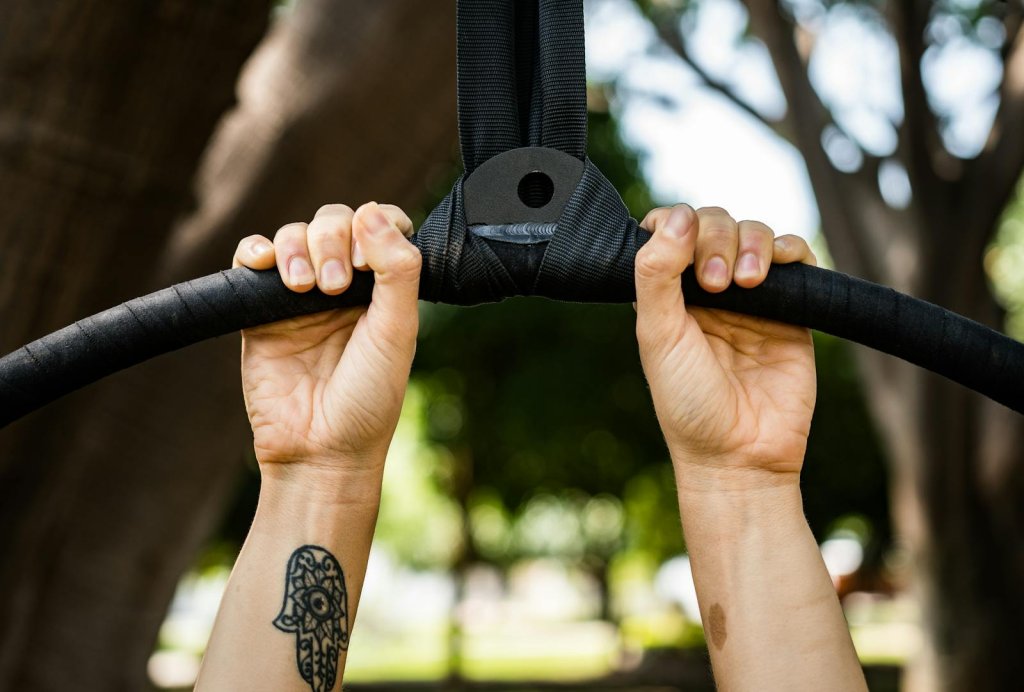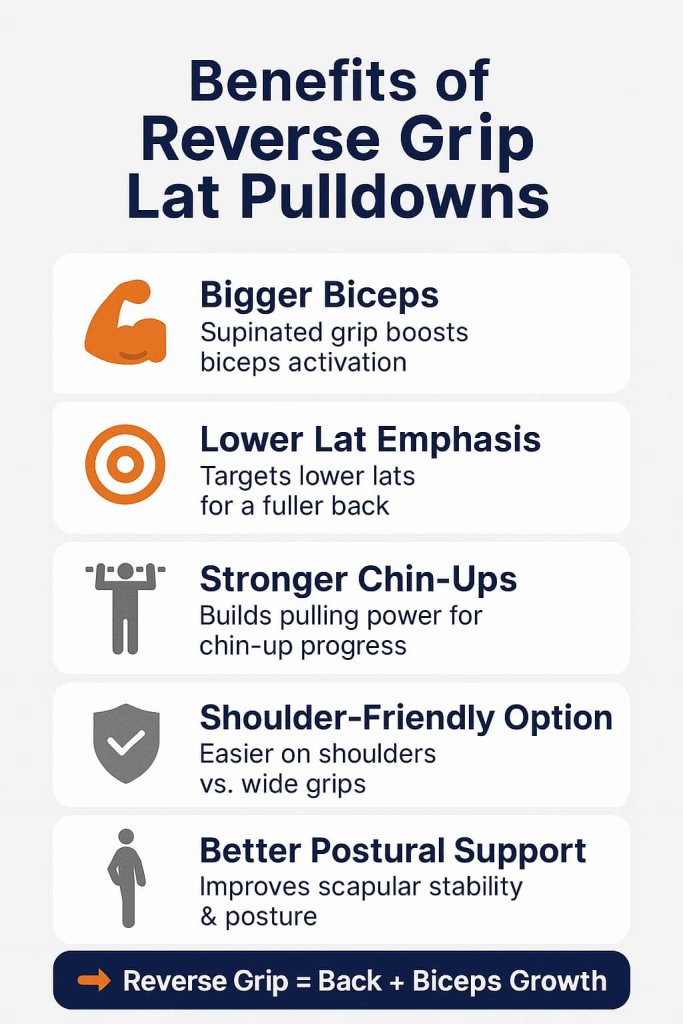Yes, the reverse grip lat pulldown is one of the best gym exercises to build a wider back and stronger biceps at the same time.

Unlike the standard overhand pulldown, the reverse grip (palms facing you) shifts more tension to your lower lats and biceps, making it a powerful accessory for anyone chasing V-taper aesthetics or better chin-up strength. Understanding how to perform it correctly ensures maximum muscle growth while protecting your shoulders and elbows.
What Is the Reverse Grip Lat Pulldown?
The reverse grip lat pulldown is a cable machine exercise where you pull a bar down toward your chest with your palms facing you (underhand/supinated grip).

- Equipment: Lat pulldown machine, wide or straight bar.
- Grip: Shoulder-width or slightly narrower, underhand.
- Movement: Pull the bar down to your upper chest, squeezing lats and biceps, then return under control.
It mimics the mechanics of a chin-up, making it an excellent progression exercise for beginners who can’t yet perform bodyweight pull-ups.
Benefits of Reverse Grip Lat Pulldowns

- Bigger Biceps
- The supinated grip activates the biceps brachii more than the traditional overhand pulldown.
- Lower Lat Emphasis
- The angle of the elbows targets the lower portion of the latissimus dorsi, giving a fuller back look.
- Stronger Chin-Ups
- Builds pulling strength in the same motion pattern as chin-ups, making progress easier.
- Shoulder-Friendly Option
- Many lifters find underhand grip easier on their shoulders compared to wide overhand pulldowns.
- Better Postural Support
- Stronger lats improve scapular stability, reducing slouching and supporting healthy posture.
Muscles Worked in Reverse Grip Lat Pulldown
- Latissimus Dorsi (Lower Lats) – main pulling muscle, emphasized by elbow path.
- Biceps Brachii (Short & Long Heads) – heavily engaged due to underhand grip.
- Brachialis & Brachioradialis – assist elbow flexion.
- Trapezius & Rhomboids – stabilize shoulder blades.
- Core & Erector Spinae – keep torso stable during pull.
How to Do the Reverse Grip Lat Pulldown (Step by Step)
- Setup
- Adjust thigh pads snugly, sit tall with feet flat.
- Grip the bar underhand, shoulder-width apart.
- Starting Position
- Lean back slightly (15–20°), chest up, core braced.
- Arms fully extended overhead, lats stretched.
- Pull Phase
- Drive elbows down and back toward ribs.
- Pull bar to upper chest (around collarbone to sternum).
- Keep wrists straight, avoid curling bar with forearms.
- Squeeze
- Hold for 1–2 seconds at bottom, contracting lats and biceps.
- Return Phase
- Slowly extend arms back up with full range.
- Keep control; don’t let weight stack slam.
Reps & Sets: 3–4 sets × 8–12 reps (hypertrophy range).
Common Mistakes to Avoid
❌ Leaning back too far – turns the movement into a row.
❌ Pulling bar too low – stopping at belly increases shoulder stress.
❌ Using momentum – swinging body reduces muscle tension.
❌ Shrugging shoulders – keep traps relaxed; let lats work.
❌ Not fully extending arms – shortens range of motion, limits growth.
Variations of Reverse Grip Lat Pulldown
1. Close-Grip Reverse Pulldown
Why it works: The narrow grip increases biceps involvement while still engaging the lats, making it a hybrid move for back and arms.
Muscles worked: Lats, biceps, brachialis, forearms.
How to do it:
- Attach a close-grip V-bar handle to the pulldown machine.
- Sit down, secure your thighs under the pad, and grab the bar with palms facing you (supinated grip).
- Pull the handle down toward your upper chest while squeezing your lats.
- Slowly release back up under control.
Trainer Tip: Keep elbows tucked close to your body—don’t flare them out.
2. Single-Arm Reverse Pulldown
Why it works: Training one side at a time corrects muscular imbalances and improves mind-muscle connection, especially helpful for lagging lats.
Muscles worked: Lats (unilateral focus), biceps, core stabilizers.
How to do it:
- Attach a single D-handle to the pulldown machine.
- Sit down and grab the handle with a supinated grip.
- Pull the handle down to your chest while keeping your torso upright.
- Return slowly to the starting position.
- Complete all reps on one side, then switch arms.
Trainer Tip: Place your free hand on your side or lat to feel the muscle working.
3. EZ-Bar Pulldown
Why it works: The angled grip of an EZ-bar reduces wrist strain while still offering strong lat and biceps activation.
Muscles worked: Lats, biceps, brachialis, forearms.
How to do it:
- Attach an EZ-bar handle to the cable machine.
- Sit down, secure your thighs, and grip the bar with a reverse (underhand) grip.
- Pull the bar down to your chest in a controlled motion.
- Slowly extend arms back up.
Trainer Tip: Keep wrists neutral—don’t overextend them. The EZ-bar’s angles should feel natural.
4. Band-Assisted Reverse Pulldown (Home Alternative)
Why it works: Great option for home training or warm-ups. Bands provide variable resistance and allow smooth, joint-friendly pulling.
Muscles worked: Lats, biceps, forearms, stabilizers.
How to do it:
- Anchor a resistance band to a sturdy overhead point.
- Kneel or sit, holding the band with an underhand grip.
- Pull the band down toward your chest, squeezing your back.
- Slowly return to starting position.
Trainer Tip: Use thicker bands for more resistance, or double them up for progressive overload.
Programming Tips
- Back Day Placement: Perform after compound lifts like barbell rows or pull-ups.
- Superset Option: Pair with overhand pulldowns for full lat development.
- Progression: Gradually increase weight while maintaining strict form.
- Beginner Tip: Start light to master technique before adding load.
FAQs About Reverse Grip Lat Pulldown
1. Is reverse grip lat pulldown better than standard pulldown?
Not better—just different. Reverse grip hits biceps and lower lats more, while overhand grip emphasizes upper lats.
2. Can I replace chin-ups with reverse grip pulldowns?
Yes, for beginners. But advanced lifters should use both for maximum strength and growth.
3. Should I use a wide or narrow grip?
A shoulder-width or slightly narrower grip is ideal—wide underhand can strain wrists and elbows.
4. Is it safe for shoulders?
Yes, many lifters find it safer than behind-the-neck pulldowns. Keep motion controlled.
5. How often should I do it?
2x per week is effective when combined with other back exercises.
6. Do reverse grip pulldowns build thickness or width?
Both—lats (width) and biceps/back thickness improve when trained consistently.
7. Can seniors or beginners do it?
Yes, with light weight and proper guidance—it’s easier to learn than pull-ups.
Conclusion
The reverse grip lat pulldown is a powerhouse exercise for developing a wide back and strong arms. By emphasizing both lats and biceps, it’s ideal for bodybuilders chasing a V-taper, athletes improving pull strength, or beginners working toward chin-ups.
👉 Add it to your back day routine, keep form strict, and you’ll see faster gains in both size and strength.
